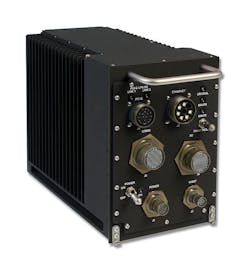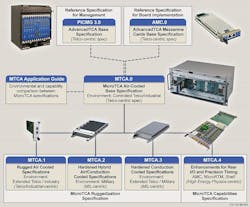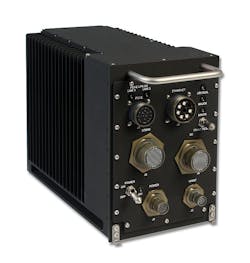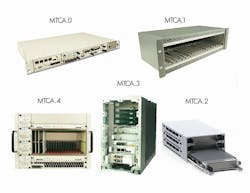MicroTCA: a compelling open COTS alternative for aerospace and defense applications
By Ian Shearer, VadaTech
In recent years, MicroTCA has seen increasing adoption in embedded computing systems for aerospace and defense applications. So why are system designers selecting MicroTCA for these applications when you have a seemingly suitable standard in OpenVPX?
On the face of it, that is not an unreasonable question. There is an implicit assumption in the embedded computing industry that OpenVPX is the default solution for many defense applications, since the standard is squarely aimed at that market. The bulk of OpenVPX sales are in military and aerospace (mil/aero), so it must be the best standard for those applications, right? But being a leading architecture is typically a historical trait, and quite different from actually being the best. While a fair amount has already been written directly comparing the two standards, it is worth looking at MicroTCA on its own merits and seeing the significant advantages it offers in this space.
MOSA
There is still a lot of emphasis on this concept in mil/aero systems: Modular Open System Architecture. Operational requirements change over time, complex systems have long development cycles, support costs far outweigh initial purchase – all good reasons why MOSA remains a focus.
Modular. Modularity is essential for any system solution based on commercial off-the-shelf (COTS) component parts. The system designer has to be able to select modular units and combine them in a way that provides the high-level functionality required of the overall system. Modularity, when implemented properly, is critical to the cost-effective maintenance regime required for any military system. MicroTCA is ideal for this. The payload cards (AMCs) can typically fit in any AMC slot in the chassis, and systems are generally configured without recourse to DIP switches or jumpers.
Open. Industry experience repeatedly shows that open standards drive down costs, enhance system functionality and speed time to market. MicroTCA, built to a family of PICMG standards, is truly open with strong platform management features to aid interoperability. Regular multi-vendor interoperability workshops are held to resolve any software issues. Where program-specific or proprietary interfaces are needed, these are easily supported with open reference designs existing for AMC-specific functionality.
System. MicroTCA supports full system implementations based on COTS hardware, with all major processors, FPGA types and interfaces being supported. Standard configurations can provide extremely high bandwidth connectivity between processing elements, and separation of management, control and data planes are inherent in the standards. The connectivity is ideal for sensor processing systems, while the telecomm heritage makes this an ideal match for network-centric warfare.
Architecture. MicroTCA is, by definition, an architecture. The physical implementation of that architecture can take different forms, and the standards are structured to support that. One of the great benefits of this approach is that applications can be readily ported across platform types with little or no change to software and IP – the architecture remains consistent. This has huge financial value to primes who are looking for commonality across product ranges, for time-to-market, cost-reduction, and ease of support reasons.
MicroTCA scores highly over OpenVPX in terms of modularity and openness. Unlike OpenVPX, MicroTCA is not dependent on patented backplane connectors, and with open-source or low-cost MMC (Module Management Controller) solutions readily available, it is easy for new vendors to bring product to market. Also, the MicroTCA specifications cover base interface (GbE), fabric interfaces (10/40GbE, PCIe, SRIO, etc.), IPMI, SATA/SAS and clock distribution, all of which are routed to all payload slots. Therefore, the backplanes are typically generic rather than project-specific, so the modularity/interoperability is much more workable. (Point-to-point signalling is supported through the Extended Options region, particularly useful for FPGA clusters and CPU/GPGPU pairing, with this being an optional addition to the standard connectivity.)
With OpenVPX, the system management is a new add-on to the specification that appears to have many difficulties. Virtually every backplane is custom and interoperability is a matter of finding a collection of customized modules unique to each vendor that works with another vendor’s customized modules. This is far from the ideal of interoperable and open.
Figure 1: This diagram from PICMG shows the relationships between the MicroTCA .1, .2, .3, and .4 specifications.
Rugged and robust
MicroTCA systems are used across the range of installation and platform types; ground fixed, ground mobile, air fixed-wing, air rotary, naval surface and naval sub-surface – with the various levels of ruggedization associated with these platform types. Figure 1 shows the relationships between the different subsidiary standards covering this, courtesy of PICMG.
MTCA.0 is the base standard for air-cooled platforms in benign environments, so typically used for ground fixed or wide-body air installations. Chassis configurations can be anything from 1U to 5U, 19-inch rackmount or smaller ‘cube’ arrangements, with front/back, side/side or bottom/top airflow.
MTCA.1 remains air-cooled, but adds retention for enhanced shock/vib performance and is used in air, ground-mobile and some naval installations. The range of off-the-shelf chassis options is slightly reduced, but any MTCA.0 AMC will generally be available in a MTCA.1 variant.
MTCA.2 puts a clamshell around the AMC to provide a hardened hybrid air/conduction cooled module. As well as enhanced thermal performance, this level of ruggedization has some distinct benefits in mil/aero applications:
· The protection provided by the clamshell allows platforms to be configured for harsh environments (humidity, salt-fog, moisture, etc).
· Testing with clamshell and wedgelock has shown the MicroTCA backplane connector to be as robust as the connectors used for VPX.[i]
· The ESD protection provided by the clamshell allows the use of a level two maintenance regime, with modules being replaced in the field without the need for ESD precautions.
Figure 2: The MicroTCA.2 and .3 specifications provide hardened versions of the systems. A MicroTCA 3/4 ATR in the conduction-cooled format is shown.
MTCA.3 provides a full conduction-cooled solution. Infrastructure elements (MCH, Power Modules) are available as COTS product, with chassis typically being provided in an ATR format (see Figure 2 for example).
At this level, MTCA.2 and MTCA.3, there is direct correspondence between MicroTCA and VPX in terms of environmental performance (shock, vibration, thermal, etc.). The MTCA.0 standard defines the physical module dimensions such that most MTCA.0 modules are capable of conversion to MTCA.2/.3 simply by appropriate clamshell design, without changing the base electronics. And because the basic board-level design remains consistent across all ruggedization levels, MicroTCA offers an economy of scale that simply is not available in OpenVPX products intended solely for defense markets.
As well as being suited to harsh environments, military systems often require reduced-capability modes to support ongoing operation in the face of damage or other partial failure. The platform management capabilities inherent in MicroTCA make it well suited to such requirements. In a typical configuration, redundant MCHs will monitor the health of power, cooling and payload AMCs. Policies can be defined that protect critical resources (e.g. with enhanced power redundancy) and functionality, giving a staged fall-back in the event of any loss.
Enhancements
A recent architectural enhancement to the MicroTCA family came in the addition of the MTCA.4 standard. Among other features, this provides for MicroRTMs, rear transition modules the same size as AMCs but with lower power consumption. Each MicroRTM is connected to only one AMC, with no direct connection to the backplane. See Figure 3 for an image showing a MicroTCA.0, .1, .2, .3, and .4 chassis.
MicroRTMs are typically used for signal conditioning or analog control, leading to mixed-signal system configurations. This brings the potential to move circuitry, which would previously have been in a separate chassis, into the MicroTCA system, saving space and enhancing reliability by reducing the amount of cabling required.
MicroRTMs are also attractive in systems requiring a large amount of I/O cabling, where this can be all be handled through the rear of the chassis. Each MicroRTM and its associated AMC can be removed separately, essential for ease of maintenance.
Product availability
Open standards are great in principle, but are only open in practice when broadly supported by industry. Standard product is readily available off the shelf from multiple vendors:
· Chassis for benign or harsh environments, for 2 to 12 AMCs
· MCH supporting PCIe, SRIO, 10GbE, 40GbE or uncommitted fabric (crossbar switch)
· Processor AMCs hosting Intel, Freescale, Cavium, or Tilera
· FPGA AMCs, with integrated ADC or RF, or with FMC site for I/O flexibility
· Data conversion and RF AMCs and FMCs
· Network interfaces and switches, graphics, storage
· Miscellaneous interfaces and carriers
As noted above, just about any of the AMCs listed above can be made available in MTCA.1, .2 or .3 format.
MicroTCA was derived from, and remains strongly associated with, AdvancedTCA (ATCA); the AMCs used in MicroTCA systems are also used in ATCA. The combined xTCA ecosystem is robust, with a large installed base and strong growth forecast. And while some standards, such as OpenVPX, are strongly focused on a single market, MicroTCA brings the volume and cost benefits of multi-market success.
Summary
Defense embedded computing systems, whether for network or sensor-based processing, benefit from the modularity, performance and flexibility of MicroTCA. At the system concept level, the architecture is a great fit for many classes of requirement. Economies of scale and being a truly open ecosystem allow MicroTCA to provide a significant cost benefit, often half the hardware cost of competing solutions. Platform management is a native component of the architecture, providing real benefits in supporting the option of failover, redundant swappability operation, etc. With ruggedization (provided through the subsidiary standards) and architectural robustness (from the telecomm legacy), MicroTCA is a natural contender for performance-critical systems.
About the author
Ian Shearer is Managing Director, EMEA, at VadaTech (www.vadatech.com).
[i] MicroTCA was tested by the same independent test house as VPX and passed to the same standards, the only difference being that MicroTCA was tested for twice as long for certain tests.



